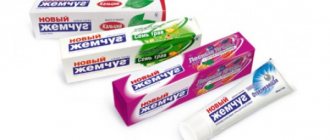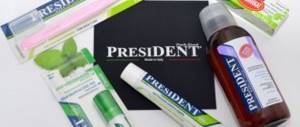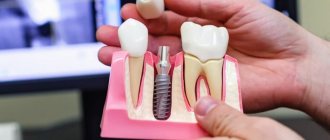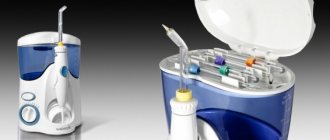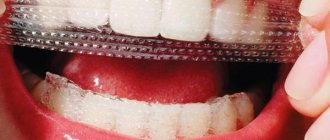Damage to tooth enamel and associated increased sensitivity of teeth is a fairly common occurrence. Some chronic diseases, bad heredity, and bad habits lead to it. The disease brings great inconvenience - because the teeth begin to react with painful impulses to cold or hot food. In advanced cases, drinking a glass of water or starting a conversation in the frosty air becomes a problem. In addition, thinning of the enamel also leads to aesthetic problems. Whitish matte spots appear on the teeth. And tooth enamel gradually loses its shine.
At the initial stage, special medicinal pastes will help cope with the problem. Today they are widely represented on the shelves of pharmacies and stores. But how to choose not just the best toothpaste for restoring tooth enamel, according to colleagues, girlfriends or marketers, but the one that can cope specifically with your problem. Let's try to understand the reasons for the thinning of tooth enamel and their consequences, and the rating of toothpastes with the effect of restoring enamel, compiled by the editors of the YaNashla website, will help with this.
Composition and normal thickness of tooth enamel
Enamel is the outer covering of the tooth; behind it is dentin, a less durable layer that is most unstable to the harmful effects of microorganisms and therefore needs protection.
Enamel consists of 96% inorganic compounds, 2-3% is water, 1% is organic substances. It can be called the most durable structure of the human body. The inorganic part of the enamel is mainly hydroxyapatites and calcium phosphates. In a healthy body, the thinning layer of these and other substances is restored by saliva. It contains a lot of phosphate ions and calcium ions, which replenish the mineral composition of the enamel, preventing its destruction. But things don't always go according to plan. Let's figure out what can lead to damage to the protective layer of teeth and what restoration methods exist. Let us pay special attention to daily care using restorative toothpastes.
Consequences of abrasion of the outer shell
Thinning of tooth enamel is a rather alarming situation; it threatens the integrity of all elements of the series. When the upper protective layer is damaged under the influence of certain factors, the inner part, the dentin, is exposed. And since this tissue is somewhat softer and more permeable than the hard shell, its destruction will be quite rapid. When the dentin boundaries are open, nothing prevents microbes from quickly penetrating into the pulp and starting the inflammatory process.
The consequence of this is the rapid destruction of bone tissue due to the development of caries, pulpitis or periodontitis. It happens that the ligaments that hold the teeth in the sockets are involved in the inflammatory process. In this case, they will inevitably be lost over time. That's why it's important not to hesitate to see a doctor at the first sign of increased tooth sensitivity, loss of shine, or staining.
Why is tooth enamel destroyed?
The quality of teeth largely depends on hereditary factors. But besides genetics, there are other reasons for the destruction of enamel. These include the following:
- smoking;
- biting hard objects;
- excessive consumption of sweets and alcohol;
- constant presence in the diet of foods high in acid (fruit juices, soda, candy);
- bruxism;
- poor oral hygiene (improper brushing, frequent use of whitening pastes, periodic whitening at the dentist, use of too hard brushes).
In addition to these factors, diseases and damage affect the quality of enamel:
- caries is one of the most popular causes of destruction of the upper layer of teeth;
- cracks in the enamel due to temperature changes when eating, lack of vitamins in the diet, imbalance in the pH balance of the oral cavity;
- erosion is a consequence of a lack of minerals in the body, frequent consumption of acidic foods, the use of hard brushes or abrasive substances for cleaning, in addition, erosion can be a sign of endocrine diseases;
- malocclusion;
- wedge-shaped defect;
- hypovitaminosis;
- metabolic disorders and improper functioning of the endocrine system;
- loss of teeth, due to which increased stress on neighboring teeth;
- hypoplasia.
Prevention of caries in young children
Prevention of childhood diseases must begin in the antenatal period, when the child is still in the womb. During the development of the embryo, the structure of its teeth is laid down - already at this stage they are saturated with mineral salts. For this to happen correctly, the expectant mother should:
- Eat right: eat foods with calcium, magnesium and other trace elements.
- Carefully observe oral hygiene: brush your teeth, use dental floss, rinses and irrigators.
- Undergo medical examinations, including by a dentist; cure caries and other dental diseases before conception or at least during pregnancy.
If you take these recommendations into account, the risk of developing dental diseases in your baby will be significantly lower. However, the prevention of childhood caries at this stage is just beginning. In principle, you will have to do it all your life. It’s just that in the first years after the birth of a baby, parents should teach him to take care of his teeth, so that later prevention becomes a part of his life.
Symptoms of enamel destruction
Despite the fact that enamel is very durable, it is vulnerable to many factors. This means that the risk of its destruction and thinning is quite high. Especially in urban environments, where it is not so easy to find quality products, poor environment and a lot of stress.
Deterioration in the quality of enamel leads to serious consequences - it increases the risk of developing caries and other diseases. It is important to remember that although saliva partially regenerates the mineral layer, this is not enough. Restoring the mineral composition requires the use of additional measures.
In different parts of the tooth surface, the thickness of the protective layer is not the same - the closer to the root, the thinner the enamel. The chewing surface, which bears the main load, can have a protective layer of up to 2-2.5 mm. But this does not mean that enamel at the roots is not important. Although this part of the tooth is not subject to much stress when chewing, it is very vulnerable. The spread of microorganisms begins from here. Pieces of food remain under the gums and between the teeth, which creates a good environment for bacteria to multiply and, of course, it is much easier for them to destroy a thin layer of enamel. When this happens, microorganisms no longer have any special obstacles to penetrate deep into the tooth. Therefore, when the enamel is damaged, carious cavities form so easily.
To prevent this from happening, it is important to determine at an early stage that the protective layer is damaged. This can be done based on the following symptoms:
- tooth sensitivity has increased - when exposed to cold, hot food, sour foods, a sharp pinching pain appears;
- pain appears with any small impact, for example, inhaling cold air;
- the teeth have become dull and have lost their shine;
- yellow spots are visible on the surface of the protective layer;
- the enamel in some areas became dull and rough, and the first signs of caries appeared.
Classification of disease prevalence
With local abrasion, only individual teeth are affected - as a rule, against the background of some acquired factors; with generalized abrasion, this problem already affects the entire dentition, and such an anomaly is usually congenital.
Symptoms of increased tooth wear
- the appearance of tooth enamel changes, it becomes uneven, rough, and tubercles appear on it;
- the natural color of the teeth changes, they become almost translucent;
- teeth acquire increased sensitivity to the effects of cold and heat, to mechanical or chemical irritants;
- sharp edges form on the enamel, which can injure the mucous membrane on the inner surface of the lips and cheeks;
- the teeth are shortened, the lower third of the face decreases in size, and folds appear in the corners of the mouth;
- hearing loss occurs and the chewing process is disrupted.
Methods for restoring tooth enamel
Today, there are many ways to restore healthy enamel thickness. Among them are: clinical treatment, traditional methods, as well as daily care with toothpaste that restores enamel.
The choice of method depends on the cause of the problem, as well as the severity of the damage. Moreover, for effectiveness, some means can be combined. But in any case, it is very important to consult a doctor first, otherwise you will waste your money and, most importantly, miss precious time.
Professional enamel restoration
The three most popular ways:
- Tissue regeneration. This method works well in the early stages of enamel damage. Its essence is that special compounds (varnishes) that transmit active substances are applied to the teeth. These varnishes are poured into a mouth guard, then the mouth guard is put on the teeth and left for some time (the exposure time depends on the active substance).
- Implantation of artificial enamel. This is an effective and completely painless way to restore the protective layer. The technique is simple: a special plastic substance is applied to the surface of the tooth, which is similar in composition to natural enamel.
- Installation of veneers. This option is used in severe cases when the enamel has been worn away almost completely. Special composite plates are placed on the teeth. They are very durable and, in addition, resistant to acids and alkalis. Veneers reliably protect the tooth from destruction. With their help you can easily create a snow-white smile. The downside is the high price.
Folk remedies
There are a lot of ways to restore enamel at home using improvised means. The advantage of such events is that they are accessible to everyone. The downside is its unconfirmed effectiveness.
The most popular options:
- rinsing with saline solution, milk or tea tree oil solution;
- gum massage (to improve blood circulation);
- applying strawberries to the surface of the teeth.
Toothpastes for restoring enamel
There are several types of toothpastes for restoring teeth. They differ in what active component is the basis.
There are fluorine-containing and calcium-containing pastes. The former are prescribed for more severe enamel damage; such pastes are quite aggressive.
There are pastes that contain both components. One of the most effective strategies is to alternate between fluoride pastes and calcium pastes. In any case, restoring enamel using pastes will take considerable time. Be prepared that you won't see results right away.
Calcium-containing toothpastes
Such pastes may contain various calcium compounds, for example, pantothenate, lactate, hydroxyapatite, and calcium citrate. To enhance the effect, components with anti-inflammatory effects are added. These can be various extracts: propolis, echinacea, calendula, chamomile, nettle and so on. It is very important that such a paste does not contain fluorine, since together with calcium it forms an insoluble salt. This means that neither calcium nor fluoride ions are released during cleaning.
Fluoride toothpastes
Before using fluoride toothpastes, you should consult your dentist. This is very important, since if used uncontrolled, there is a risk that there will be too much fluoride in the body (fluorosis), which will lead to brittle teeth and bones.
When choosing pastes with fluoride, you need to pay attention to the amount of active substance and what fluoride compound is used. The most popular options are sodium fluoride and amino fluoride. Fluorine rate in paste: 1350-1500 ppm.
Prevention of caries in preschool children
After the eruption of baby teeth, a child may develop bottle caries. It occurs due to poor hygiene. Breast milk contains a lot of sugar. If you don't wash the bottle and pacifier or leave it in your newborn's mouth overnight, bacteria will grow rapidly in your newborn's mouth. As a result, already the first temporary teeth will suffer from caries.
To prevent this from happening, you need to thoroughly wash the bottle and pacifiers, and also clean the baby’s teeth and gums with special silicone fingertips. At one year old, you can buy him a brush with soft bristles. At about 1.5-2 years old, you should start using children's toothpaste. Every 3-4 months you should bring your baby to the dentist for an examination. These measures help prevent the development of caries or detect it at the very beginning of its development.
By the age of 2.5-3 years of a child’s life, all temporary teeth have grown in. If he has already been diagnosed with caries and the likelihood of its reoccurrence is high, the silvering technique is used. The doctor coats the baby’s teeth with silver ions, which have an antibacterial effect. This procedure is quite effective, but it has one significant drawback - the enamel treated with silver darkens, and this cannot be corrected. He will have a beautiful snow-white smile only after his molars grow in.
To prevent caries in preschool children, endogenous and exogenous methods are used. The first include measures related to saturating the body with vitamins and minerals. It is necessary to balance the child’s diet, exclude harmful foods from the diet and include healthy foods rich in calcium. If necessary, the doctor will prescribe medications that contain phosphorus, fluorine, magnesium and vitamins.
Exogenous methods of prevention are measures aimed at protecting enamel from external factors. Such measures include:
- choosing the right toothbrush with age-appropriate bristles;
- regular use of flosses, rinses and irrigators;
- coating the enamel with fluorine-containing compounds that strengthen it and protect it from bacteria.
It is advisable that a doctor select a toothbrush and toothpaste for the child. He will also talk about other methods of preventing caries in children of preschool and school age.
Toothpaste that restores tooth enamel, “ASEPTA PLUS” REMINERALIZATION
"ASEPTA PLUS" REMINERALIZATION refers to calcium-containing toothpastes. It contains:
- hydroxyapatite – this substance is the main component of tooth enamel;
- thermal mud - beneficial elements in its composition have a soothing and healing effect on the gums and also help strengthen the enamel;
- the enzyme papain helps rid teeth of plaque;
- zinc – slows down the formation of tartar;
- Eleutherococcus extract and calendula extract protect the mucous membrane from inflammation and help speed up the healing of soft tissues.
The paste is suitable for both prevention and restoration of enamel in case of various damages, for example, after chemical bleaching. The effect becomes noticeable after four weeks.
To see the result as quickly as possible, it is recommended to brush your teeth with ASEPTA PLUS REMINERALIZATION paste twice a day for two minutes.
When the protective shell is at risk: what to do to restore weakened enamel
Do you know what is the thinnest, only a few millimeters, and at the same time the strongest tissue in our body? This is enamel, which is designed to protect our teeth from external influences. The outer shell is even harder than bones; it can withstand a load of more than 100 kilograms per tooth. However, even the most stable structure of the body, alas, becomes thinner over the years. And since it is not nourished by blood vessels, it, unfortunately, cannot recover on its own. So it is very important to take care of it. Timely restoration of tooth enamel should be a priority so that teeth do not decay prematurely.
It is no secret that the condition of our entire body depends on the strength of our teeth. From this article you will learn how enamel guards our health, what causes it to weaken, and what to do to restore its damaged integrity.
Clinical researches
Clinical studies have proven that regular use of professional toothpaste ASEPTA REMINERALIZATION improved the condition of the enamel by 64% and reduced tooth sensitivity by 66% after just 4 weeks.
Sources:
- Report on the determination/confirmation of the preventive properties of personal oral hygiene products “ASEPTA PLUS” Remineralization doctor-researcher A.A. Leontyev, head Department of Preventive Dentistry, Doctor of Medical Sciences, Professor S.B. Ulitovsky First St. Petersburg State Medical University named after. acad. I.P. Pavlova, Department of Preventive Dentistry
- Report on determining/confirming the preventive properties of commercially produced personal oral hygiene products: Asepta toothpaste used in combination with Asepta mouthwash and Asepta gum balm Head. Department of PFS Doctor of Medical Sciences Professor S.B. Ulitovsky St. Petersburg State Medical University named after Academician I.P. Pavlova. Faculty of Dentistry. Department of Preventive Dentistry.
- Clinical and laboratory assessment of the influence of domestic therapeutic and prophylactic toothpaste based on plant extracts on the condition of the oral cavity in patients with simple marginal gingivitis. Doctor of Medical Sciences, Professor Elovikova T.M.1, Candidate of Chemical Sciences, Associate Professor Ermishina E.Yu. 2, Doctor of Technical Sciences Associate Professor Belokonova N.A. 2 Department of Therapeutic Dentistry USMU1, Department of General Chemistry USMU2
